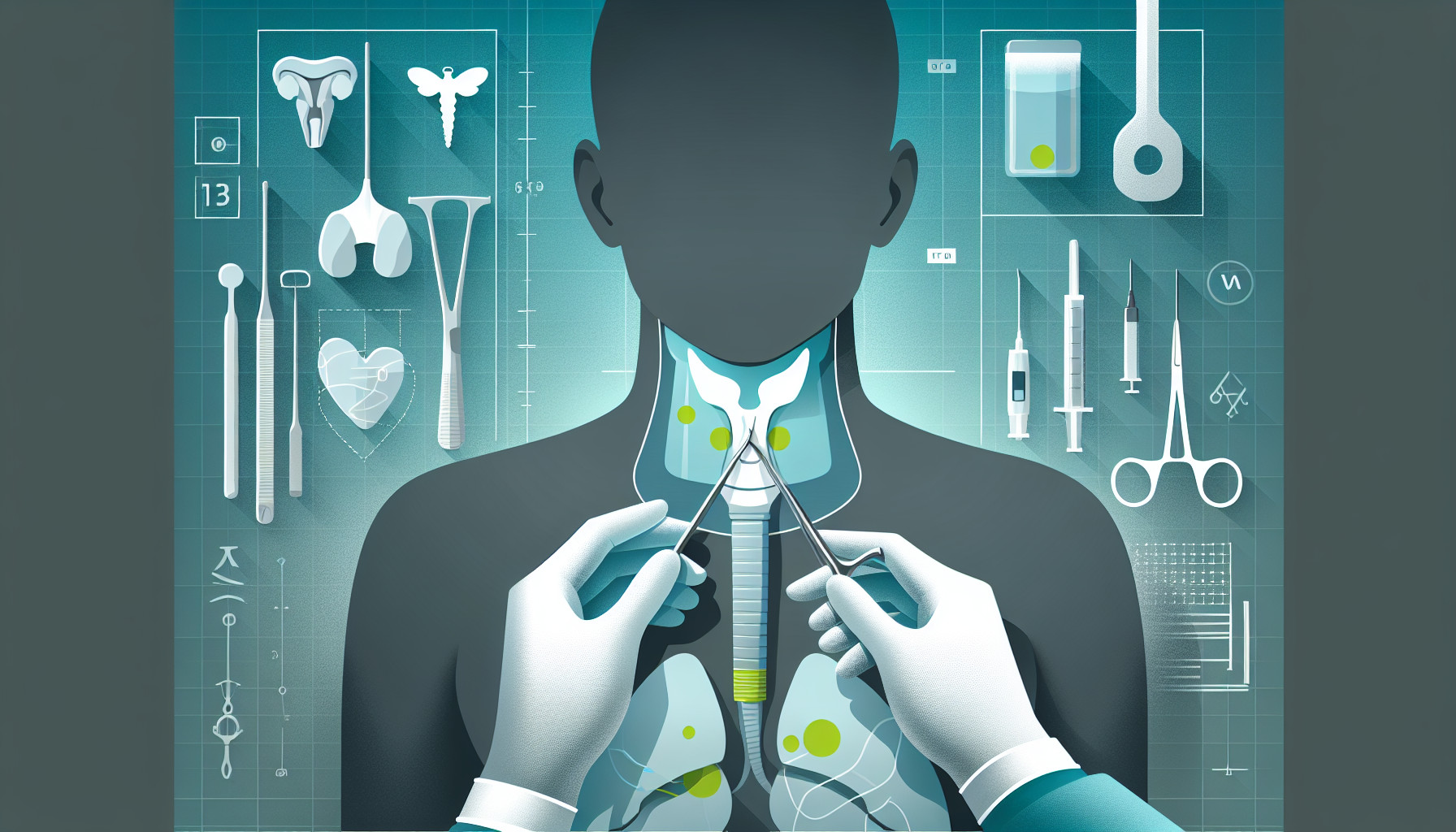Our Summary
This research paper discusses a new surgical procedure called the transoral endoscopic thyroidectomy vestibular approach (TOETVA), which is used to remove the thyroid gland without leaving a scar on the neck. However, this technique comes with its own risks, and the authors present two cases where the patients’ airways were damaged during the surgery. In the first case, due to the patient having an inflamed thyroid and Graves’ disease, the surgeons had to switch to a traditional open surgery to fix a small tear in the membrane around the thyroid. In the second case, the patient experienced a fracture in the neck area, which the surgeons were able to repair using the endoscope. The authors conclude that while both traditional and TOETVA surgeries carry the risk of airway damage, the risk is higher with TOETVA due to the instruments used and the location of the incision.
FAQs
- What is the transoral endoscopic thyroidectomy vestibular approach (TOETVA) procedure?
- What kind of complications can occur during the TOETVA procedure?
- Is the risk of airway damage higher in TOETVA compared to traditional thyroidectomy?
Doctor’s Tip
A doctor might advise a patient undergoing thyroidectomy to carefully follow their post-operative care instructions, including keeping the incision site clean and dry, avoiding strenuous activities, and taking prescribed medications as directed. It is important for patients to report any unusual symptoms or complications, such as difficulty breathing, excessive swelling, or signs of infection, to their healthcare provider immediately. Additionally, patients should follow up with their doctor for regular monitoring of their thyroid hormone levels to ensure proper function and adjust medication as needed.
Suitable For
Patients who may be recommended for a thyroidectomy include those with:
Thyroid cancer: Patients with thyroid cancer may undergo a thyroidectomy to remove the cancerous thyroid tissue.
Hyperthyroidism: Patients with hyperthyroidism, such as Graves’ disease, may undergo a thyroidectomy if other treatments are not effective in controlling their symptoms.
Large goiters: Patients with large goiters that are causing symptoms such as difficulty breathing or swallowing may require a thyroidectomy to remove the enlarged thyroid gland.
Thyroid nodules: Patients with thyroid nodules that are suspicious for cancer or causing symptoms may undergo a thyroidectomy for further evaluation and treatment.
Recurrent thyroid nodules: Patients with recurrent thyroid nodules that continue to grow or cause symptoms despite other treatments may require a thyroidectomy.
Family history of thyroid cancer: Patients with a family history of thyroid cancer or certain genetic conditions that increase the risk of thyroid cancer may be recommended for a thyroidectomy as a preventive measure.
Pregnant women: Pregnant women with thyroid nodules or cancer may undergo a thyroidectomy to prevent potential harm to the fetus or to address thyroid-related complications during pregnancy.
It is important for patients to discuss their individual medical history and treatment options with their healthcare provider to determine if a thyroidectomy is the best course of action for their specific condition.
Timeline
Before Thyroidectomy:
- Patient undergoes initial evaluation and consultation with a healthcare provider to discuss symptoms and potential treatment options
- Patient may undergo various diagnostic tests such as blood tests, ultrasound, and biopsy to confirm the need for surgery
- Patient may need to prepare for surgery by adjusting medications and fasting before the procedure
- Patient undergoes thyroidectomy surgery, either traditional open surgery or the TOETVA approach
- Patient is monitored in the recovery room for any immediate complications
After Thyroidectomy:
- Patient may experience pain, swelling, and discomfort in the neck area
- Patient may need to stay in the hospital for a few days for monitoring and recovery
- Patient may need to take medications for pain management and to regulate hormone levels
- Patient may need to follow a special diet to support healing and manage potential side effects such as weight gain
- Patient may need to attend follow-up appointments with their healthcare provider to monitor healing and adjust medications as needed
- Patient may need to undergo thyroid hormone replacement therapy to manage symptoms of hypothyroidism
- Patient may need to undergo physical therapy or speech therapy to address any changes in voice or swallowing function
- Patient may need to monitor for any complications such as infection, bleeding, or damage to surrounding structures
- Patient may need to make lifestyle changes such as avoiding certain foods or activities to support recovery and long-term health.
What to Ask Your Doctor
- What are the reasons for recommending a thyroidectomy in my case?
- What are the potential risks and complications of a thyroidectomy, particularly with the TOETVA approach?
- How experienced are you with performing thyroidectomies, especially with the TOETVA technique?
- What is the recovery process like after a thyroidectomy, and how long can I expect to be out of work or normal activities?
- Will I need to take medication for thyroid hormone replacement after the surgery?
- Are there any alternative treatments or less invasive procedures that could be considered instead of a thyroidectomy?
- How will my vocal cords be affected by the surgery, and what is the likelihood of experiencing voice changes or hoarseness?
- How often will I need follow-up appointments after the surgery, and what signs or symptoms should I watch for that may indicate a complication?
- Will there be a scar visible on my neck after the surgery, even with the TOETVA approach?
- Are there any specific lifestyle changes or dietary restrictions I should follow after a thyroidectomy?
Reference
Authors: Long SM, Ali K, Tufano RP, Banuchi VE. Journal: Head Neck. 2022 Feb;44(2):E6-E10. doi: 10.1002/hed.26909. Epub 2021 Nov 3. PMID: 34729859
